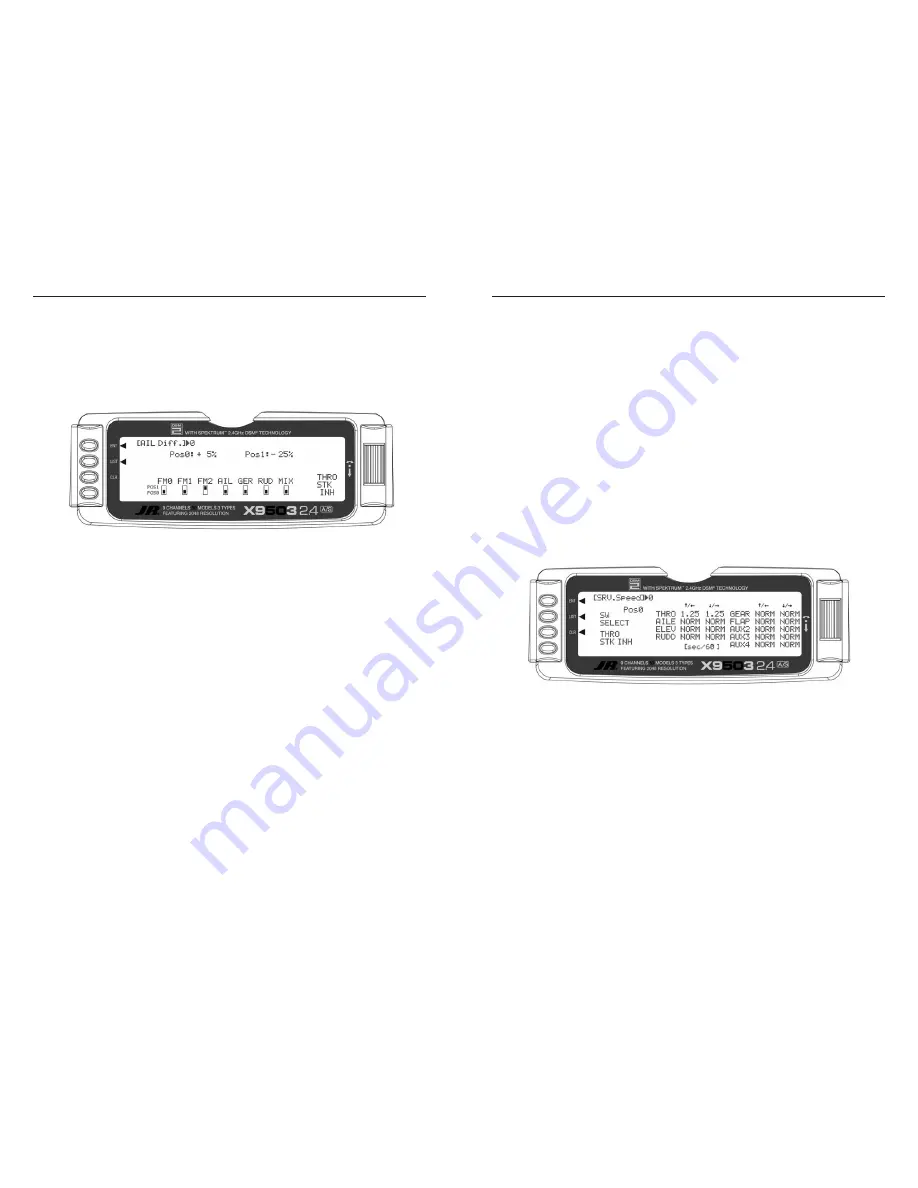
AIL DIFF. – AILERON DIFFERENTIAL (continued)
SRV.SPEED – SERVO SPEED
A-34
A-35
2. If using 2 Aileron differential values you can select a
switch to control the differential amount and set each
position as desired. If one of these values is set to
zero, Aileron differential can be turned off by selecting
the position that has the 0 values. Highlight and select
Pos0
and set a small percentage of differential or
leave it set to zero (0) if the ability to turn differential
off is desired. Highlight and select
Pos1
and set the
percentage of differential. A positive value causes the
downward Aileron to travel less, while a negative value
causes the upward Aileron to travel less (negative
differential). The example below shows a positive
percentage in
Pos0
for precision flying and a negative
differential for
Pos1
for flat spins, which is selectable
with Flight Mode 2 (FM2).
3. Scroll down to the bottom line of the display to select
the Flight Mode and/or switch(es) that will switch
between the Aileron Differential settings. You can also
use the throttle to switch between differential settings
by highlighting and selecting
THRO STK
and setting
the percentage of throttle to the point where the values
are switched. Test fly the aircraft and return to this
function to make adjustments until eliminating the yaw
tendency.
Note
: Pos1 always has priority over Pos0. If you
select multiple switches and one of the switches is in
its Pos1 position, then all other switches are ignored
and the Pos1 values are in effect.
The X9503 2.4 system provides the ability to adjust the
speed of servos on each channel in both directions. The
speed may be adjusted downward (servo slowed) from its
normal speed but it cannot cause a servo to move faster
than its rated specifications. Furthermore, each servo can
have 2 sets of speeds in both directions that are Flight
Mode or switch selectable.
The servo speed function is very useful for scale models
with retractable landing gear and gear doors, since in
many instances the need for gear door sequencers can be
eliminated. If the gear door servos move at normal speed
and the landing gear servos move at a slower speed when
the gear is lowered, the gear doors will be open before
the landing gear begins to come down. In the opposite
direction, if the gear door servos move slowly and the
landing gear servos move at normal speed, the gear can
retract before the gear doors begin to close.
Note
: Most mechanical retract servos are non-
proportional type servos that simply move from
endpoint to endpoint. These types of servos are not
adjustable in the servo speed function.
Servo speed can also be useful on the throttle channel.
The throttle servo can be slowed down such that the
engine will not flame out because the carburetor is opened
or closed too quickly when the throttle stick is jammed
from low to high and vice versa.
To adjust servo speed, highlight and select
SRV.Speed
in the
FUNC.LIST
.
1. If there is to be a single set of servo speeds in effect all
of the time, make sure the display is showing
Pos0
. If
it is not, select
Pos1
and change it to
Pos0
.
Highlight and select the channel and direction for each
servo you will adjust. Once a direction for a servo is
selected, the servo speed may be set so the servo travels
from .176 seconds for 60 degrees of rotation all the way
up to 15 seconds for 60 degrees of rotation. Adjust the
speed of each servo until the desired speed is obtained.
The example below shows the throttle servo slowed down
so that it traverses 60 degrees in 1.25 seconds in both
directions. That is all that is required when there is only 1
set of servo speeds.
2. If using 2 sets of servo speeds that are Flight Mode or
switch selectable, you can select a switch to control the
servo speed and set each position as desired. If one
set of values is set to
NORM
for all channels, slowing
of servos can be turned off by selecting the position
(Pos0 or Pos1) that has the
NORM
values. Highlight
and select
Pos0
and change it to
Pos1
then highlight
and select the channel and direction for each servo you
will adjust. Once a direction for a servo is selected, the
servo speed may be set so the servo travels from .176
seconds for 60 degrees of rotation all the way up to 15
seconds for 60 degrees of rotation. Adjust the speed
of each servo until the desired speed is obtained.
Highlight and select
Pos0
then highlight and select
the channel and direction for each servo that is to be
adjusted. Switch between
Pos0
and
Pos1
to view and
adjust the 2 sets of values for each servo.
3. Scroll over to and select
SW SELECT
to identify
the Flight Mode and/or switch(es) used to switch
between the 2 sets of servo speeds. The throttle may
also be used to switch between differential settings by
highlighting and selecting
THRO STK
and setting the
percentage of throttle to the point where the values are
switched.
Note
: Pos1 always has priority over Pos0. If you
select multiple switches and one of the switches is in
its Pos1 position, then all other switches are ignored
and the Pos1 values are in effect.
The X9503 2.4 has a Snap Roll system comprised of a
Содержание X9503 2.4
Страница 43: ...A 56...
Страница 103: ...S 68...
Страница 107: ...2010 Horizon Hobby Inc 4105 Fieldstone Road Champaign IL 61822 USA 877 504 0233 www horizonhobby com Printed 11 09 16661...






























